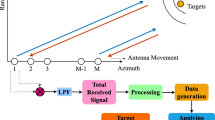Abstract
The rapid development of compressive sensing (CS) shows that it is possible to recover a sparse signal from very limited measurements. Synthetic aperture radar (SAR) imaging based on CS can reconstruct the target scene with a reduced number of collected samples by solving an optimization problem. For multichannel SAR imaging based on CS, each channel requires sufficient samples for separate imaging and the total number of samples could still be large. We propose an imaging algorithm based on distributed compressive sensing (DCS) that reconstructs scenes jointly under multiple channels. Multi-channel SAR imaging based on DCS not only exploits the sparsity of the target scene, but also exploits the correlation among channels. It requires significantly fewer samples than multi-channel SAR imaging based on CS. If multiple channels offer different sampling rates, DCS joint processing can reconstruct target scenes with a much more flexible allocation of the number of measurements offered by each channel than that used in separate CS processing.
Similar content being viewed by others
References
Ian G C, Frank H W. Digital Processing of Synthetic Aperture Radar Data: Algorithms and Implementation. Norwood, MA: Artech House, 2005
Emmanuel J C, Justin R, Terence T. Robust uncertainty principles: Exact signal reconstruction from highly incomplete frequency information. IEEE Trans Inf Theory, 2006, 52: 489–509
Emmanuel J C, Terence T. Near-optimal signal recovery from random projections: universal encoding strategies. IEEE Trans Inf Theory, 2006, 52: 5406–5425
David L D. Compressed sensing. IEEE Trans Inf Theory, 2006, 52: 5406–5425
Emmanuel J C, Michael B W. An introduction to compressive sampling. IEEE Signal Process Mag, 2008, 25: 21–30
Marco F D, Shriram S, Dror B D, et al. Distributed compressed sensing of jointly sparse signals. In: 39th Asilomar Conf on Signals, Systems and Computers, 2005, 24: 1537–1541
Dror B, Marco F D, Shriram S, et al. Distributed compressive sensing. “Distributed compressed sensing,” Technical Report, TREE0612, Rice University, Houston, TX, Nov. 2006. Available at http://dsp.rice.edu/cs/
Mariví T, Paco L D, Jordi J M. A novel strategy for radar imaging based on compressive sensing. IGARSS 2008, II: 213–216
Yeo Y, Moeness G A. Compressed sensing technique for high-resolution radar imaging. SPIE Signal Process Sensor Fusion Target Recog, 2008, 6968,1: 1–10
Ivana S W, Clem K, Mujdat C. Compressed sensing of mono-static and multi-static SAR. SPIE Algor Synth Apert Radar Imag, 2009, 73370,5: 1–12
Zhang L, Xing M D, Qui C W, et al. Achieving higher resolution ISAR imaging with limited pulses via compressed sampling. IEEE Trans Geosci Remote Sens Lett, 2009, 6: 567–571
Emmanuel C, Justin R. Sparsity and incoherence in compressive sampling. Inverse Prob, 2007, 23: 969–985
Charles V J, Daniel E W, Paul H E, et al. Spotlight-mode Synthetic Aperture Radar: a Signal Processing Approach. Boston: Kiluwer Academic Publishers, 1996
Shen C, Chuck L. A comparison of displaced phase centre antenna and along-track interferometry techniques for RADARSAT-2 ground moving target indication. Can J Remote Sens, 2005, 31: 37–51
Derin B, Rafael M, Aggelos K K. Bayesian compressive sensing using laplace priors. IEEE Trans Image Process, 2010, 19: 53–63
Author information
Authors and Affiliations
Corresponding author
Rights and permissions
About this article
Cite this article
Lin, Y., Zhang, B., Jiang, H. et al. Multi-channel SAR imaging based on distributed compressive sensing. Sci. China Inf. Sci. 55, 245–259 (2012). https://doi.org/10.1007/s11432-011-4452-z
Received:
Accepted:
Published:
Issue Date:
DOI: https://doi.org/10.1007/s11432-011-4452-z




